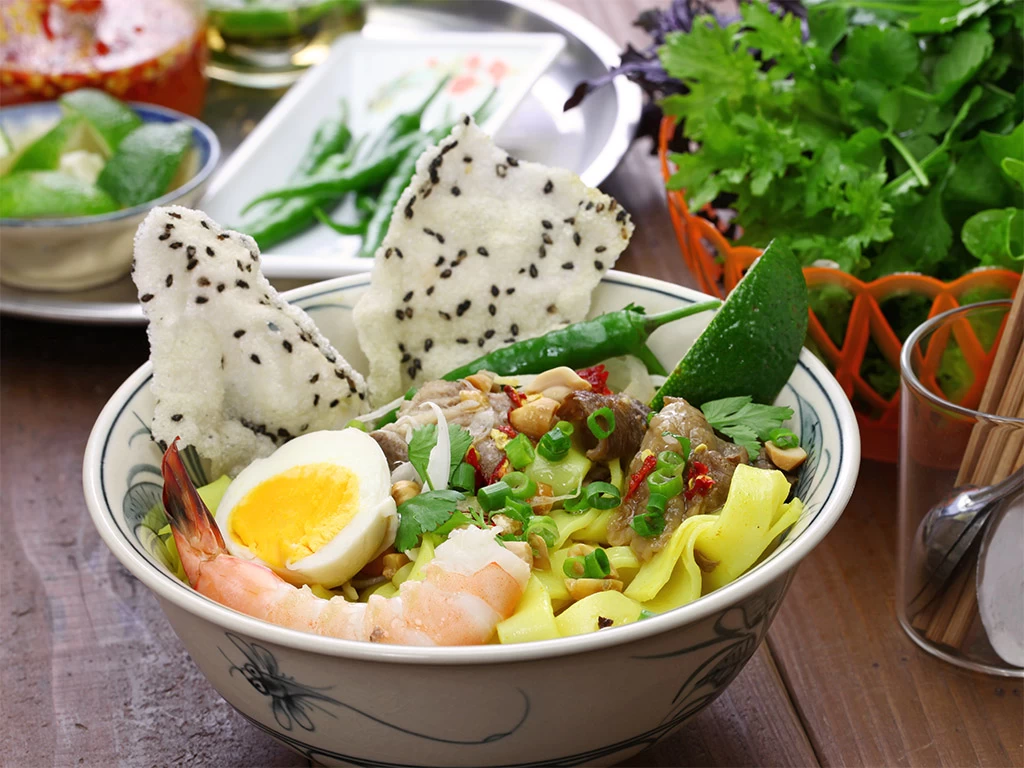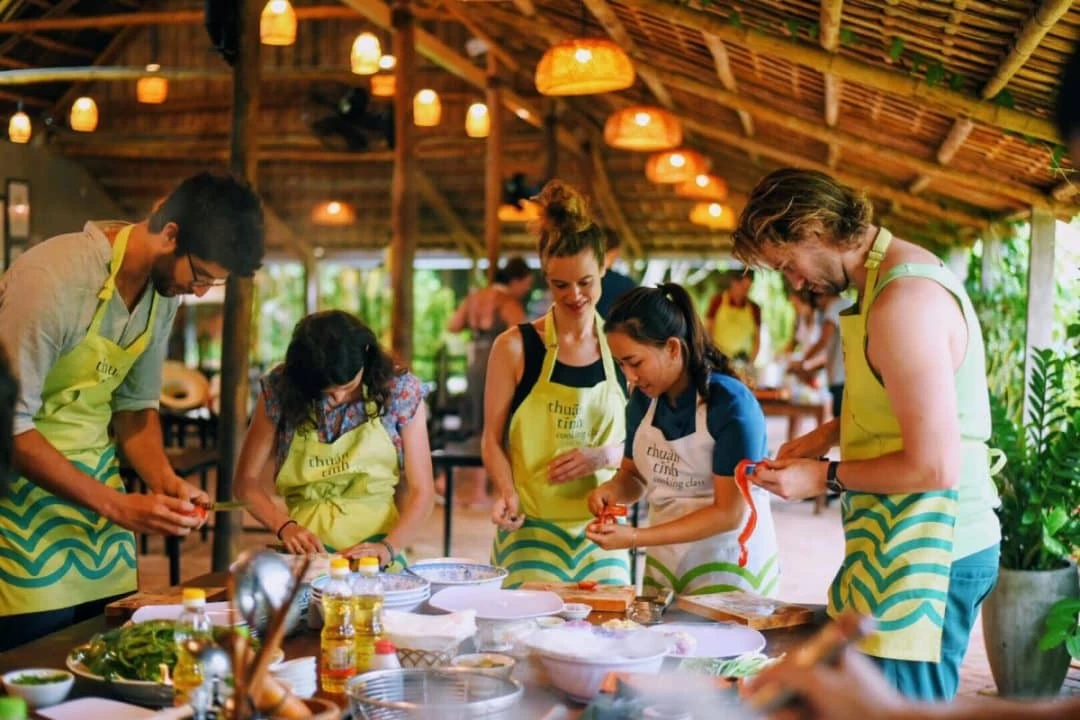
Experience The real local life in Hoi An
Discover the authentic local life in Hoi An through a myriad of activities, specialty dishes, and traditional craft villages. Immerse yourself in the vibrant culture of this ancient town as you explore its bustling markets, savor its culinary delights such as Cao Lau and Mi Quang, and witness the time-honored craftsmanship of Thanh Ha pottery village and Tra Que vegetable village. Experience the essence of Hoi An’s rich heritage and community spirit firsthand with Ula Travel today.
I. Overview of Hoi An
1. Geographical Location
Hoi An is a historic city located in Quang Nam Province in central Vietnam. Positioned on the banks of the Thu Bon River, it lies approximately 30 kilometers south of Da Nang. This prime location not only makes it easily accessible from major transportation hubs but also places it at a crossroads of ancient trade routes. The city’s proximity to the coastline has historically made it a bustling port town, enhancing its significance in both historical and contemporary contexts.
2. History and culture
Hoi An’s history dates back to the 15th century, when it was established as a major trading port in Southeast Asia. The city flourished as a bustling hub for merchants from Japan, China, Portugal, and other countries, contributing to its rich cultural tapestry. The architecture in Hoi An reflects this diverse influence, with well-preserved buildings showcasing a unique blend of Vietnamese, Chinese, and Japanese styles.

Hoi An is a World Heritage Site recognized by UNESCO
The cultural heritage of Hoi An is deeply embedded in its daily life and festivals. The city’s layout and infrastructure have remained relatively unchanged for centuries, allowing visitors to step back in time as they stroll through its narrow streets. UNESCO recognized Hoi An as a World Heritage Site in 1999, highlighting its cultural and historical importance.
II. Hoi An’s Appeal to International Tourists
1. Ancient Charm
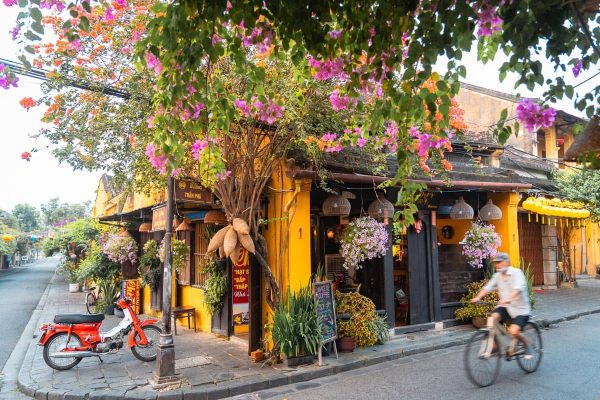
Hoi An Ancient Town
Hoi An captivates international tourists with its timeless beauty and historical ambiance. The ancient town is a living museum where visitors can explore centuries-old buildings, traditional wooden houses, and iconic structures such as the Japanese Covered Bridge. The harmonious combination of architectural styles provides a visual narrative of Hoi An’s multicultural past. Walking through the lantern-lit streets at night, visitors are transported to a bygone era, experiencing the serene and romantic atmosphere that defines Hoi An Ancient Town.
2. Blend of Tradition and Modernity
Hoi An is not just about its historical allure; it seamlessly blends tradition with modernity. While preserving its rich heritage, the city has embraced contemporary amenities to cater to the needs of modern travelers. Boutique hotels, trendy cafes, and international restaurants coexist with traditional markets and craft shops, offering a unique juxtaposition of old and new.
Click here: Hoi An Tours
III. Daily Local life in Hoi An
Hoi An, a charming ancient town in Vietnam, offers a unique glimpse into the daily lives of its residents, who blend tradition with a relaxed lifestyle. From the early hours of the morning to the calm of the evening, the daily rhythm of local life in Hoi An is a captivating mix of cultural practices and simple living.
Morning Routine
The day typically begins early in Hoi An, as the locals embrace the cooler morning hours. Around 5:00 AM, the town awakens with the soft hum of bicycles and motorbikes as residents head to the local markets or nearby fields. Many locals start their day with a visit to the nearest pagoda to offer prayers and burn incense, seeking blessings for the day ahead.
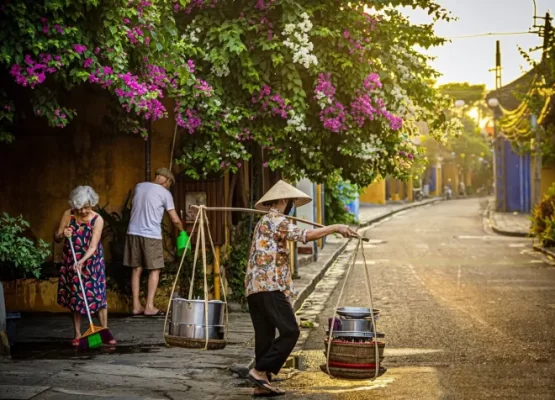
Simple morning of people in Hoi An
Breakfast is a significant part of the morning routine. Street vendors and small eateries start bustling with activity, serving traditional Vietnamese breakfast dishes like pho (noodle soup), banh mi (a Vietnamese sandwich), and various sticky rice dishes. The local coffee culture is also prominent, with people enjoying their morning cup of strong, aromatic Vietnamese coffee at roadside cafes, often accompanied by a leisurely chat with friends or family.
Midday Activities
As the morning progresses, many locals engage in their daily work, whether it be running a small business, crafting traditional lanterns, or working in the rice fields. Hoi An is renowned for its skilled artisans, and you can often see tailors, carpenters, and lantern makers at work, continuing the town’s rich heritage of craftsmanship.
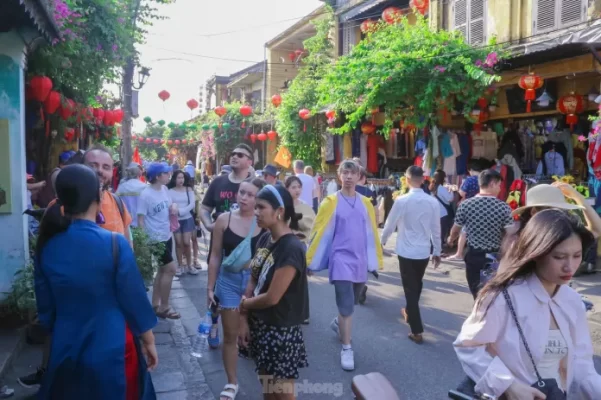
Hoi An is bustling in the middle of the day
Lunchtime, typically around 11:30 a.m. to 1:00 p.m., is an important family affair. Many businesses close temporarily as locals return home to enjoy a meal with their family, followed by a short siesta to escape the midday heat.
Afternoon and Evening
The afternoon in Hoi An often sees a continuation of work or preparation for the evening market activities. Children return from school and can be seen playing in the narrow alleys or helping their parents with household chores.

Hoi An becomes sparkling with lights in the evening
As the sun sets, the town’s atmosphere shifts. Locals often gather along the Thu Bon River or at community centers for social activities, including folk games and traditional music performances.
More details: Discover Central Vietnam Tour in 6 Days
IV. Experience Local Life in Hoi An
1. Participating in traditional classes
a. Cooking Classes in Hoi An
One of the most enriching ways to immerse yourself in the local culture of Hoi An is by taking a cooking class. These classes offer a hands-on experience that not only teaches you how to cook traditional Vietnamese dishes but also provides insights into the local ingredients and culinary techniques that have been passed down through generations.

A Cooking Class in Hoi An
Overview of Cooking Classes in Hoi An
- Duration and Structure: Most cooking classes last between 3 and 5 hours and often start with a trip to a local market. Here, you’ll learn about and select fresh ingredients, guided by a local chef.
- Cuisine Focus: Traditional Vietnamese Food
Popular cooking schools in Hoi An
- Red Bridge Cooking School: Located by the river, this school offers a comprehensive experience, starting with a market tour and a boat trip to the cooking venue.
- Tra Que Vegetable Village Cooking Class: This class not only focuses on cooking but also includes a tour of the organic vegetable village, providing a deeper understanding of local farming practices.
- Green Bamboo Cooking School: Known for its small class sizes and personalized instruction, it allows participants to choose the dishes they wish to learn.
Benefits of Taking a Cooking Class
- Cultural Immersion: Gain a deeper appreciation for Vietnamese culture and traditions.
- Culinary Skills: Learn new recipes and techniques to recreate the dishes at home.
- Social Interaction: Meet fellow travelers and locals, making the experience enjoyable and interactive.
Start your journey with: Explore Hoi An in 1 Day
b. Lantern-making classes in Hoi An
Hoi An is famous for its beautiful lanterns, which symbolize luck, happiness, and prosperity. Taking a lantern-making class offers a unique way to engage with this aspect of the town’s cultural heritage.
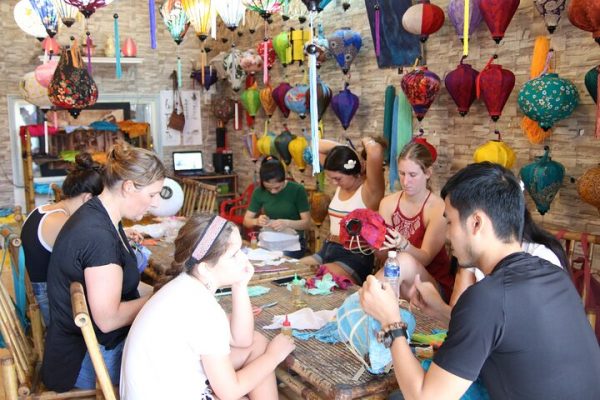
Lantern-making class in Hoi An
Overview of Lantern-Making Classes
- Duration and Structure: Lantern-making classes typically last about two hours. You’ll be guided through the entire process, from constructing the frame to decorating the lantern with vibrant silk fabrics.
- Types of Lanterns: Learn to make traditional cylindrical lanterns as well as more intricate shapes like lotus flowers.
Popular lantern-making workshops in Hoi An
- The Lantern Ladyis a well-known local artisan who offers workshops in her charming studio. Participants can choose from a variety of designs and colors.
- Pho Hoi Lantern Workshop: This workshop provides a comprehensive experience, allowing participants to create a lantern from scratch and take it home as a souvenir.
- Reaching Out Arts and Crafts: An inclusive space supporting disabled artisans. Here, you can learn how to make lanterns while supporting a good cause.
Benefits of Taking a Lantern-Making Class
- Creative Expression: Express your creativity and design a unique lantern.
- Cultural Insight: Understand the significance of lanterns in Vietnamese culture and festivals, especially the famous Hoi An Lantern Festival.
- Memorable Souvenir: Take home a beautiful handmade lantern as a tangible memory of your time in Hoi An.
Are you looking for: Central Vietnam Wonders Tour
2. Traditional crafts in Hoi An
Hoi An is not only known for its charming ancient town and delicious cuisine but also for its vibrant traditional crafts. These crafts provide a window into the local culture and offer visitors unique experiences. Among the most notable are lantern making, Thanh Ha pottery, and Tra Que vegetable farming.
a. Thanh Ha Pottery Village
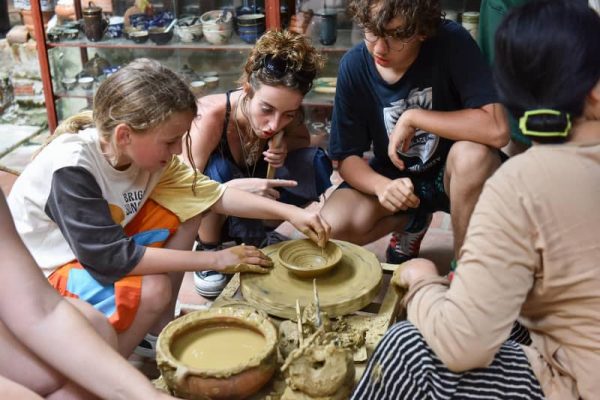
Tourists experience pottery making at Thanh Ha pottery village.
The Thanh Ha pottery village, located just a few kilometers from Hoi An’s ancient town, has a history that spans over 500 years. This village is renowned for its high-quality ceramics, which are made using traditional techniques passed down through generations.
Visitor Experience:
- Visitors can explore the Thanh Ha Pottery Village to observe the entire pottery-making process. Many workshops offer pottery classes where tourists can try their hand at molding and painting their own ceramic pieces.
- The village also features a pottery museum showcasing antique ceramics and the history of the craft.
b. Tra Que Vegetable Village

Experience farmer life in Hoi An
Tra Que Vegetable Village, situated just a short bike ride from Hoi An, is known for its organic farming practices and fresh, flavorful produce. The village has been cultivating vegetables for over 300 years, using traditional methods that contribute to the unique taste and quality of the crops.
Visitor Experience:
- Tourists can visit Tra Que to learn about traditional farming techniques and participate in various activities, such as planting, watering, and harvesting vegetables.
- Many tours include a cooking class where visitors can use the freshly harvested vegetables to prepare local dishes, offering a farm-to-table experience.
- The village also offers scenic views and a tranquil atmosphere, making it a perfect spot for those looking to escape the hustle and bustle of the town.
You might also like: Da Nang to Hoi An in 4 Days
3. Experiencing local markets in Hoi An
a. Hoi An Market
Hoi An Market, located in the heart of the ancient town, is a bustling hub of activity that offers a true glimpse into local life. Open daily from early morning until late in the evening, this market is a treasure trove for those looking to immerse themselves in the vibrant culture and everyday routines of Hoi An’s residents.
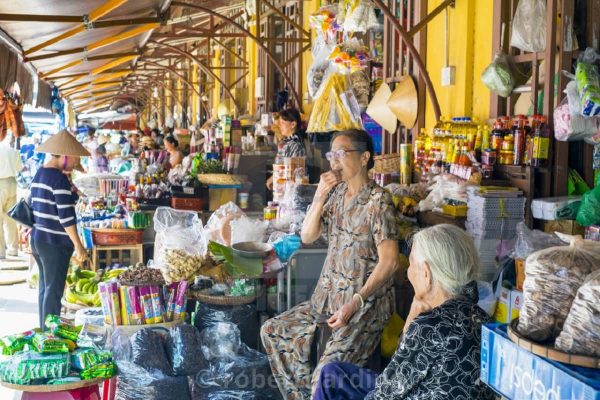
The local market is a place that clearly shows local life
Diverse Offerings:
- Fresh Produce: The market boasts an array of fresh fruits, vegetables, herbs, and spices. The vivid colors and fragrant aromas provide a sensory feast, making it a perfect spot for food enthusiasts.
- Local Handicrafts: From handwoven textiles to intricately designed lanterns, Hoi An Market is an excellent place to shop for unique souvenirs and gifts. These handicrafts not only showcase the skill of local artisans but also make for meaningful keepsakes.
- Clothing and Accessories: Tailor-made clothing is a highlight in Hoi An, and the market is home to numerous stalls offering custom tailoring services. You can choose from a wide range of fabrics and designs to create bespoke garments.
Bargaining Tips:
- Be Polite and Friendly: Bargaining is expected, but it’s essential to approach it with a friendly demeanor. Polite haggling can make the experience enjoyable for both you and the vendor.
- Know the Local Prices: Having a rough idea of the standard prices for certain goods can help you negotiate more effectively.
- Start low: Begin with a lower offer and gradually work your way up to a price that satisfies both parties.
Interaction with Locals:
- Engaging with the vendors and other shoppers offers a rich cultural exchange. Many of the stall owners are happy to share stories and information about their products, giving you a deeper understanding of Hoi An’s traditions and lifestyle.
Learn more about: Discover My Son Sanctuary from Hoi An and Street Food Tour
b. Enjoying Cuisine at the Night Market
Hoi An Night Market, located on Nguyen Hoang Street, comes alive after sunset. It is a culinary haven for food lovers, offering an array of delicious street food that reflects the rich culinary heritage of the region.

Enjoying Cuisine at the Hoi An Night Market
Must-Try Dishes:
- Cao Lau: A regional specialty made with thick noodles, pork, greens, and a savory broth. The unique flavor of Cao Lau is attributed to the specific water used in ancient Cham wells around Hoi An.
- Banh Mi: Often touted as one of the best sandwiches in the world, Hoi An’s Banh Mi is a must-try. Vendors offer various fillings, including pork, pate, vegetables, and fresh herbs, all packed into a crispy baguette.
The Atmosphere:
- Vibrant and Lively: The night market’s lively atmosphere, with its colorful lights and energetic crowds, makes it an exciting place to explore. Street performers and musicians often add to the festive mood, making it a memorable experience.
- Social Dining: Eating at the night market is a communal activity. Shared tables and bustling food stalls create opportunities to meet and interact with other travelers and locals alike.
Tips for Enjoying the Night Market:
- Come Hungry: With so many delicious options, it’s best to arrive with an empty stomach to fully enjoy the variety of food available.
- Try a Little of Everything: Instead of filling up on one dish, sample small portions from different stalls to experience the full range of flavors.
- Stay Hygienic: While street food is generally safe to eat, it’s wise to choose stalls that are busy and have a high turnover of food, ensuring freshness and quality.
Learn more about: Top 10 Must-Try Dishes in Ho An
V. Travel tips for Visitors
1. Best Time to Visit Hoi An
Hoi An has two main seasons: the dry season and the rainy season.
- Dry Season (February to August): This is the best time to visit Hoi An. The weather is warm and sunny, perfect for exploring the town and nearby beaches. March to May is particularly pleasant, with moderate temperatures and less humidity.
- Rainy Season (September to January): While this period sees more rainfall, it can still be a charming time to visit. The rain often comes in short bursts, leaving plenty of time to explore between showers. Additionally, the town is less crowded, and accommodations are often cheaper.
Click here: Best Time to Visit Hoi An -Travel Tips for Your Itinerary 2024
2. Transportation
Getting to Hoi An from Da Nang
Hoi An does not have its own airport, so most travelers fly into Da Nang International Airport, which is about 30 kilometers away. From Da Nang, there are several ways to reach Hoi An:
- Taxi or private car: the most convenient option, especially if you have a lot of luggage or are traveling in a group. The trip takes about 45 minutes and costs around $15–25 USD.
- Shuttle Bus: Several shuttle bus services operate between Da Nang Airport and Hoi An. They are cheaper than taxis and provide a comfortable ride. Tickets cost around $6–8 USD.
- Public bus: the most economical option, though less convenient. Bus number 1 runs between Da Nang and Hoi An, with tickets costing less than $1 USD. However, the bus can be crowded, and it makes many stops along the way.
In conclusion, exploring the local life in Hoi An unveils a tapestry of cultural richness and authentic experiences that captivate travelers. From the vibrant daily rhythm to the traditional culinary delights and the intricate artisanal crafts, Hoi An offers a glimpse into the soul of Vietnam. Whether wandering through the ancient streets of the Old Town, immersing in the bustle of local markets, or partaking in hands-on workshops, visitors are treated to an unforgettable journey of discovery. Embrace the essence of local life in Hoi An, where every alleyway tells a story, and every encounter paints a vivid portrait of Vietnamese hospitality and heritage.
See more: Hoi An Travel Tips




